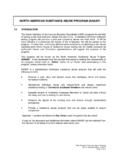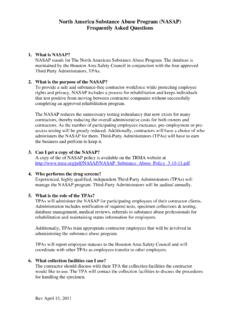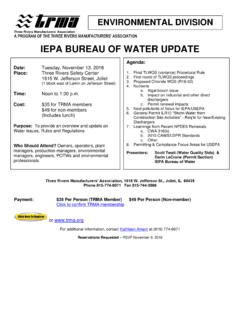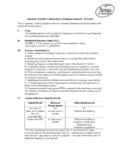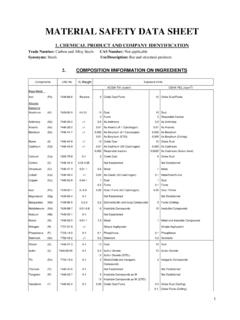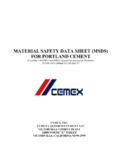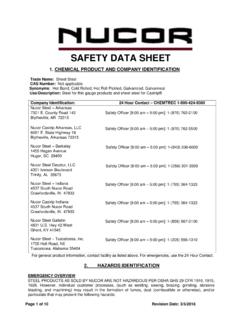Transcription of SAMPLE INDUSTRIAL HYGIENE PROGRAM - TRMA
1 ATTACHMENT A TRMA GUIDE TO CONTRACTOR INDUSTRIAL HYGIENE programs INDUSTRIAL HYGIENE PROGRAM TEMPLATE EXAMPLE Rev. 6 03-14-07 Page 1 of 8 [This is an example of a general INDUSTRIAL HYGIENE PROGRAM intended to help INDUSTRIAL Hygienists in the development of a specific contractor IH PROGRAM if one is not yet developed. It is not intended to be a final PROGRAM but rather a helpful starting point for one. Each company will have differences in how their PROGRAM will function; those should be described in the written procedures. The key element addressed in detail below is the exposure assessment process since many other PROGRAM components would already be addressed in their own separate programs .]
2 Some sections below have only a general topic area described leaving it up to the person developing the PROGRAM to determine what is needed to fit the specific needs of the contract company. A contractor IH PROGRAM should be considered for all work locations not just those requiring it, similar to uniform safety procedures across all sites. ] XYZ Contract Company INDUSTRIAL HYGIENE PROGRAM PURPOSE This PROGRAM is intended to help ensure the health and safety of our employees, those of our sub-contractors, and those of the host sites we work at. Additionally this PROGRAM will assist us in meeting the host sites commitment to safety and health and in meeting regulatory requirements. SCOPE This PROGRAM applies to all of our activities at our main office / shop locations, and at host sites.
3 Contractors working at any facility that is a part of the Three Rivers Manufacturing Association. It is expected that any subcontractors to us will also have an equally as effective PROGRAM in place unless we elect to include them under this PROGRAM . REFERENCES American Conference of Governmental INDUSTRIAL Hygienists (ACGIH) Guide to Occupational Exposure Values and Threshold Limit Values for Chemical Substances and Physical Agents & Biological Exposure Indices American INDUSTRIAL HYGIENE Association (AIHA) Qualitative Exposure Assessment Process Occupational Safety and Health Administration (OSHA) Technical Manual and Analytical Methods National Institute for Occupational Safety and Health (NIOSH) Sampling Guide Regulations found under 29 CFR 1910 Regulations found under 29 CFR 1926 DEFINTIONS Certified INDUSTRIAL Hygienist (CIH)
4 A professional INDUSTRIAL hygienist who by education, experience, and demonstration of knowledge has satisfied the requirements of the American Board of INDUSTRIAL HYGIENE and ahs been designated a CIH in either the comprehensive practice or chemical aspects of the profession. Exposure Assessment Determination or estimation (qualitative or quantitative) of the magnitude, frequency, duration, and route of exposure. NIOSH - Part of the Centers for Disease Control and Prevention within the Department of Health and Human Services. Responsibilities include research and recommending occupational health and safety standards. OSHA Part of the Department of Labor; the regulatory and enforcement agency for safety and health for most business and INDUSTRIAL sectors.
5 Qualified INDUSTRIAL Hygienist (QIH) Individuals by virtue of adequate experience, training, education, board certification or a combination of these factors are competent to provide INDUSTRIAL HYGIENE related services. ATTACHMENT A TRMA GUIDE TO CONTRACTOR INDUSTRIAL HYGIENE programs INDUSTRIAL HYGIENE PROGRAM TEMPLATE EXAMPLE Rev. 6 03-14-07 Page 2 of 8 RESPONSIBILITIES Certified INDUSTRIAL Hygienist (CIH) Assist in the development of the IH PROGRAM . Approve the PROGRAM as meeting generally accepted IH standards of practice. Provide ongoing general IH oversight of the PROGRAM .
6 Conduct annual PROGRAM reviews of the PROGRAM . Review monitoring documentation. Verify personnel conducting monitoring are properly qualified to perform the activities assigned. Verify the quality of exposure evaluations and monitoring is acceptable. Provide recommendations based on assessments. Develop annual exposure evaluation plans. Qualified INDUSTRIAL Hygienist (QIH) Works under the guidance of a CIH - Conduct qualitative and/or quantitative exposure assessments - Assists in developing applicable OSHA programs /procedures - Verify personnel conducting monitoring are properly qualified to perform the activities assigned. - Provide recommendations based on assessments. - Develop annual exposure evaluation plans.
7 Site Supervisors Understand the potential health hazards of the work being done and in the areas worked. Evaluate these potential health hazards as part of a pre-job safety review. Ensure workers are aware of the potential hazards and the controls in place to minimize potential exposures. Request assistance from safety or IH personnel as needed in evaluating conditions. Site Safety Personnel Maintain a basic level of IH hazard awareness. Evaluate jobs for potential health hazards utilizing prior training, PPE assessments, and exposure evaluations. Request assistance from an IH as needed for evaluations or monitoring. Ensure controls needed to minimize exposures remain effective.
8 Site Monitoring Technician (or IH Technician) Maintain IH equipment, Calibrate equipment per guidelines Maintain adequate documentation Collect samples and handle afterwards using approved procedures Other activities as approved by the CIH In addition the person should have a basic level of IH hazard recognition. The CIH overseeing the PROGRAM will verify that this person has the appropriate qualifications to perform the scope of their assigned activities. ATTACHMENT A TRMA GUIDE TO CONTRACTOR INDUSTRIAL HYGIENE programs INDUSTRIAL HYGIENE PROGRAM TEMPLATE EXAMPLE Rev. 6 03-14-07 Page 3 of 8 Employees Understand the potential health hazards of the materials being worked with or around.
9 Utilize proper PPE consistent with Hazard Communication and PPE training. Report any problems or concerns to the supervisor. EXPOSURE EVALUATIONS The Contractor s IH PROGRAM shall consist of two major components, a qualitative and quantitative exposure assessment. These assessments will need to be developed by a Certified INDUSTRIAL Hygienist or a Qualified INDUSTRIAL Hygienist with CIH oversight to ensure good quality control. These assessments can be summarized and provided to field personnel as part of their IH hazard awareness training and to assist them in conducting a pre-job safety analysis. Qualitative Assessments The Contractor shall use the American INDUSTRIAL HYGIENE Associations (AIHA) Qualitative Exposure Assessment Process as guide for this section of the PROGRAM .
10 Contractors shall use the elements listed below and additional information provided in the AIHA guide to develop and document their qualitative assessment PROGRAM /procedure. The qualitative assessment will be conducted by a CIH or a QIH under the guidance of a CIH. The process uses the following basic steps: A listing of all significant work tasks including work task frequency, duration, and conditions Potential chemicals involved for each task. Interviews and field observations about each work task made as needed. Work tasks grouped into similar exposure groups. Develop exposure groups based on exposure potential and chemical / physical hazards Develop a risk matrix (example in appendix) to identify high risk vs.

